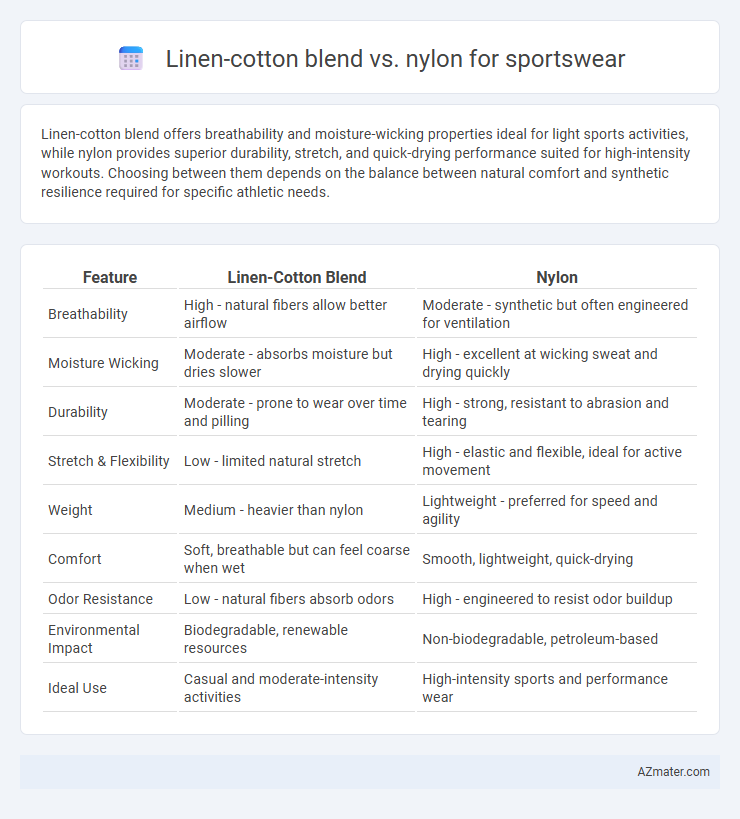Linen-cotton blend offers breathability and moisture-wicking properties ideal for light sports activities, while nylon provides superior durability, stretch, and quick-drying performance suited for high-intensity workouts. Choosing between them depends on the balance between natural comfort and synthetic resilience required for specific athletic needs.
Table of Comparison
| Feature | Linen-Cotton Blend | Nylon |
|---|---|---|
| Breathability | High - natural fibers allow better airflow | Moderate - synthetic but often engineered for ventilation |
| Moisture Wicking | Moderate - absorbs moisture but dries slower | High - excellent at wicking sweat and drying quickly |
| Durability | Moderate - prone to wear over time and pilling | High - strong, resistant to abrasion and tearing |
| Stretch & Flexibility | Low - limited natural stretch | High - elastic and flexible, ideal for active movement |
| Weight | Medium - heavier than nylon | Lightweight - preferred for speed and agility |
| Comfort | Soft, breathable but can feel coarse when wet | Smooth, lightweight, quick-drying |
| Odor Resistance | Low - natural fibers absorb odors | High - engineered to resist odor buildup |
| Environmental Impact | Biodegradable, renewable resources | Non-biodegradable, petroleum-based |
| Ideal Use | Casual and moderate-intensity activities | High-intensity sports and performance wear |
Introduction to Linen-Cotton and Nylon in Sportswear
Linen-cotton blends combine the natural breathability and moisture-wicking properties of linen with the softness and durability of cotton, making them ideal for lightweight, comfortable sportswear. Nylon, a synthetic fiber known for its exceptional strength, elasticity, and quick-drying capabilities, is widely used in high-performance athletic apparel. The choice between linen-cotton blend and nylon depends on the specific sportswear requirements such as airflow, durability, and moisture management.
Fabric Composition and Key Characteristics
Linen-cotton blend sportswear combines natural fibers offering breathability, moisture absorption, and softness, ideal for comfort during low to moderate physical activities. Nylon sportswear, composed of synthetic polyamide fibers, delivers superior durability, elasticity, and moisture-wicking properties, making it suitable for high-intensity workouts. The lightweight and quick-drying attributes of nylon contrast with the natural texture and eco-friendly nature of linen-cotton blends, influencing performance and care requirements.
Moisture-Wicking and Breathability Comparison
Linen-cotton blends offer excellent breathability due to natural fibers that allow air circulation, making them suitable for moderate exercise, while nylon excels in moisture-wicking by quickly drawing sweat away from the skin to the fabric's surface for evaporation. The hydrophobic nature of nylon enhances drying speed and reduces clinginess compared to linen-cotton, which tends to absorb moisture and dry slower. For high-intensity sports, nylon's superior moisture management and durability provide better performance, whereas linen-cotton blends prioritize comfort and temperature regulation in low-impact activities.
Comfort and Skin Sensitivity
Linen-cotton blends offer superior breathability and moisture-wicking qualities, making them ideal for athletes with sensitive skin prone to irritation. The natural fibers reduce the risk of allergic reactions compared to synthetic materials like nylon, which can trap heat and cause chafing during prolonged wear. For sportswear focused on comfort and skin sensitivity, linen-cotton blends provide a cooler, softer fabric experience that minimizes sweat buildup and enhances overall skin health.
Durability and Wear Resistance
Linen-cotton blend offers moderate durability, combining natural fibers that provide breathability but may show wear faster under intense physical activity, while nylon excels in wear resistance due to its synthetic composition, offering superior strength and abrasion resistance essential for high-performance sportswear. Nylon's resilience against tearing and stretching makes it ideal for rigorous movements, whereas linen-cotton blends prioritize comfort but require more frequent replacement in demanding conditions. Choosing nylon ensures longer-lasting sportswear with maintained structural integrity under repeated stress.
Weight and Flexibility in Athletic Use
Linen-cotton blends offer lightweight breathability with natural moisture-wicking properties, ideal for moderate athletic activities where comfort and temperature regulation are priorities. Nylon, known for its exceptional flexibility and durability, provides a lightweight yet highly elastic fabric that supports dynamic movements and intense workouts. Choosing between linen-cotton and nylon depends on prioritizing natural ventilation and softness versus superior stretch and resilience in sportswear performance.
Style, Aesthetics, and Color Options
Linen-cotton blends offer a natural, breathable texture that enhances casual sportswear with a relaxed and sophisticated aesthetic, featuring muted, earthy color palettes ideal for understated elegance. Nylon excels in vibrant color retention and sleek finishes, providing high-gloss, bold options favored in performance-driven sportswear for a modern and dynamic look. The choice between linen-cotton and nylon balances the desire for organic, textured style against bright, durable color vibrancy in athletic apparel.
Sustainability and Environmental Impact
Linen-cotton blend sportswear offers enhanced sustainability due to the natural, biodegradable fibers that reduce environmental impact through lower water usage and decreased reliance on synthetic chemicals compared to nylon. Nylon, a synthetic fiber derived from petroleum, has a higher carbon footprint and contributes to microplastic pollution during washing cycles, raising environmental concerns. Choosing linen-cotton blend fabrics supports eco-friendly production practices by minimizing waste and promoting renewable agricultural resources in sportswear manufacturing.
Maintenance and Care Requirements
Linen-cotton blend sportswear requires gentle washing with mild detergents and air drying to prevent fabric shrinkage and maintain breathability, while nylon sportswear offers easier maintenance due to its wrinkle resistance and quick-drying properties. Nylon fabrics can handle machine washing and occasional tumble drying without losing shape, making them highly suitable for high-performance sports activities. Proper care of linen-cotton blends ensures longevity by avoiding harsh chemicals and excessive heat, contrast to nylon's durable and low-maintenance nature.
Best Applications: Choosing the Right Fabric for Your Sport
Linen-cotton blend offers breathability and moisture-wicking properties ideal for low-impact sports like yoga and casual outdoor activities where comfort and natural fibers are prioritized. Nylon excels in durability, stretch, and quick-drying capabilities, making it the preferred choice for high-intensity sports such as running, cycling, and water-based activities. Selecting the right fabric depends on activity level, climate, and required performance features, with linen-cotton blends best for relaxed, breathable wear and nylon suited for rigorous, performance-driven sportswear.

Infographic: Linen-cotton blend vs Nylon for Sportswear
 azmater.com
azmater.com